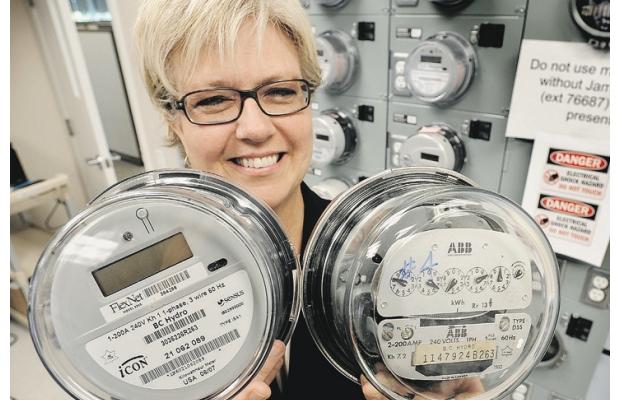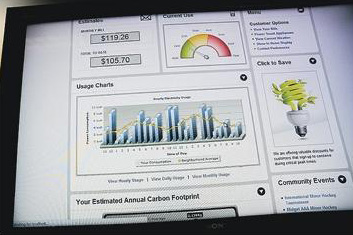$930-million program upgrades B.C. power grid and offers users options like turning off lights remotely via a laptop or web-enabled phone
Scott Simpson
Sun

Fiona Taylor, BC Hydro smart metering and infrastructure acting director, holds a new smart meter (left) and an old meter. The new system will allow Hydro to supply power at a level very close to actual demand. Photograph by: Bill Keay, PNG, Vancouver Sun

A new in-home program that will show household power usage and other information. Photograph by: Bill Keay, PNG, Vancouver Sun

Photograph by: Bill Keay, PNG, Vancouver Sun
BC Hydro is making room for both technophiles and technophobes on the $930-million smart meter network it will introduce in 2012.
Hydro expects to recoup all of its investment within about eight years — and then net about $500 million in subsequent savings — even if its 1.8 million customers in British Columbia don’t adopt the suite of new, interactive features that the high-tech electricity meters can provide.
About 150 jurisdictions worldwide are adopting the technology, which represents the first significant upgrade of meter technology since the 1950s — “since we had rotary phones,” according to Hydro smart metering and infrastructure acting director Fiona Taylor.
“It really is a technology-rich infrastructure initiative that is part of a whole program to modernize the grid,” Taylor said Thursday during a tour of Hydro’s smart meter research and development facility in Burnaby.
“We’ve designed it in a way that is very focused on customer choice and control. It has an extremely positive business case.”
Adds Cindy Verschoor, communications leader for the program, “It allows us to reach into the system in a way we’ve never been able to before and take advantage of capacity and energy savings that are there — but we haven’t been able to get to [previously], because the system was old.”
Right now, the system runs sort of like a car with no gas gauge — Hydro can make educated guesses about how much electricity its customers are using, but it is obliged, in essence, to keep the system topped up in order to avoid a brownout.
Nor does Hydro find out about a local blackout until a customer phones to tell them about it. And Hydro linemen cannot determine if they’ve restored power until they see someone’s porch light blink back on.
The new system will report that information automatically, and will allow Hydro to supply power at a level very close to actual demand. Hydro expects it will be able to conserve power as a result, saving money that will eventually be passed back to its customers.
“Today’s grid is old, and it’s blind,” Taylor said. “With our project, as more eyes to the system, we have the ability to determine where the power is going, where we are losing it.”
Hydro has been studying a half-dozen different meter designs, but has yet to announce a deal with a manufacturer. There are 25 million smart meters on back order in North America at present.
David Deyagher, solutions architect for the program, said the corporation is still working to determine if a single meter design will suit all of B.C., or if the province’s rugged geography will force a more patchwork approach to keeping all Hydro ratepayers connected.
It takes about five minutes to install a new meter along the side of a home, or in the utility room of an apartment or condo complex. While the meters have digital readouts instead of a series of spinning gears to track electricity consumption, they don’t really look much different from the 20th-century glass-dome devices they will replace.
The meters eliminate the need for meter readers to go house to house collecting data, (an issue that has raised alarm among labour leaders in jurisdictions such as California and British Columbia.)
The devices will have the capacity for wireless communication with Hydro, giving the utility near-instant updates on
Technology architect David Deyagher shows the various consumer devices that can be used with this new system.
electricity consumption — and the capacity for more sophisticated management of electricity supply across a region, even the entire province.
If you’re comfortable with the technology, you’ll be able to add to the functionality of the meter by adding in-home devices — everything from BlackBerry-sized digital readout panels
Today’s grid is old, and it’s blind. With our project, as more eyes to the system, we have the ability to determine where the power is going, where we are losing it.
Fiona Taylor Hydro smart metering
you can Velcro to a wall, to a “smart” clothes dryer or other large appliance that respond to “price signals” from Hydro.
Customers will be able to program the digital readout panel to make animal noises to remind their kids to turn out the lights when they leave their bedrooms.
You’ll be able to turn lights off and on in your home through a new Hydro smart meter web portal you can access from anywhere, via a laptop or phone with web capability.
You’ll also be able to contract with Hydro to put you into a special electricity rate class that charges you so-called “market” prices for electricity — which can significantly rise or fall in a matter of minutes on the North American power trading market in which Hydro is an active participant.
Some jurisdictions, such as Ontario, are forcing all their customers into multi-tiered rate programs that virtually demand sophisticated programming choices and in-home devices to interact with the outdoor meters.
Hydro’s approach is much less aggressive.
You can stay with the existing two-tier rate if you wish, and never give the new system another thought.
If you want to take a more hands-on approach to managing consumption, you will have to buy from a third party — such as a hardware or electronics store — the in-home device that interacts wirelessly on a Wi-Fi bandwidth with the smart meter outside your home.
A recent U.S. smart meter pilot study in the Pacific Northwest found that utility customers who participated in an interactive power management programs cut their power bills by 30 to 40 per cent.
Hydro is estimating savings of between $145 and $450 per year for customers who adopt the technology.
© Copyright (c) The Vancouver Sun
